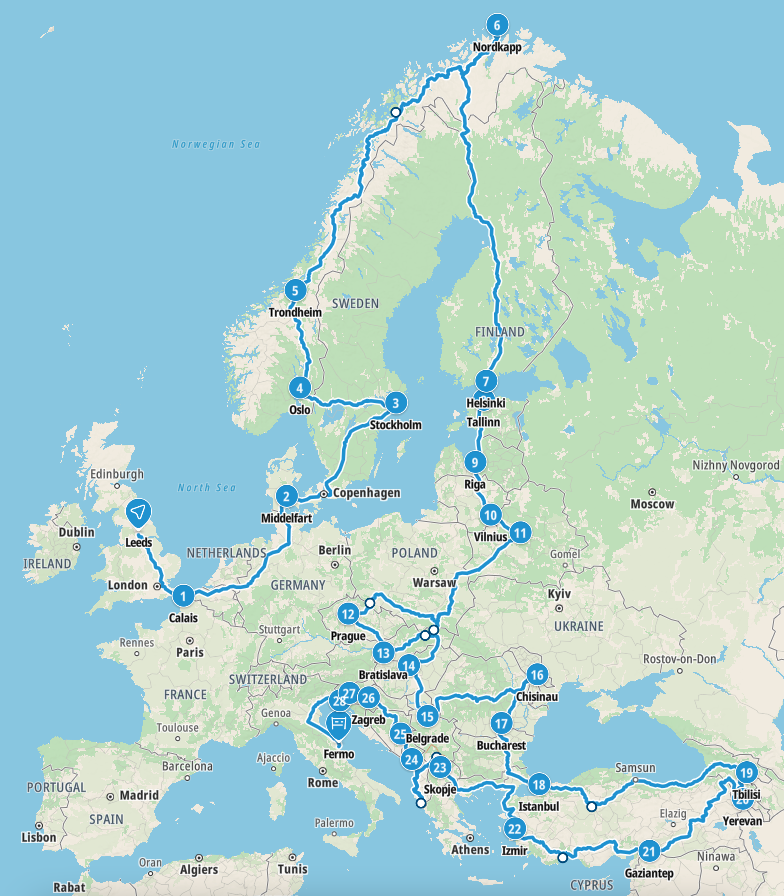Planning your journey
When planning a road trip there are many factors that you need to take into consideration. With our years of experience, Let’s explore here can help you make your dreams and plans a reality.
First things first though, you’ll need to decide a few things ahead of time:
Where do you want to go?
Take a look at our destination guides to help you understand more about each country.
Reviewing maps and then creating a rough route map should help you to understand the relationships between different countries. This will help you to understand distances between different places and how much time it can take to travel there.
In many parts of Europe for example, some countries are relatively small, and thus it’s quite easy to get around the whole country in a short amount of time. Some countries however are much larger than you might at first imagine, and can take a very long time to traverse.
Terrain should also be taken into account, and modern SatNavs are quite good at taking into account the differences in terrain, thus providing much more accurate journey times.
Constantly reviewing the forward look at weather conditions is essential in overland travel. Reviewing multiple weather prediction sites should be undertaken to obtain the most accurate view. Planning ahead and obtaining e.g. snow chains and winter tyres can literally save your life.
This is an example of quite a long route that we planned across Europe. Our planned road trip moved from the UK – FRA – BEL – LUX – NLD – DEU – DNK – SWE – NOR – FIN – EST – LVA – LTU – POL – CZE – SVK – HUN – SRB – ROU – MDA – BUL – UKR – TUR – GEO – ARM – AZE – TUR – GRC – MKD – MNE – KOS – ALB – BIH – HRV – SVN – ITA – SMR – AUT – LIE – CHE – MCO – FRA – AND – ESP – PRT – GIB.

Visas
Take a look at our visa guide to help you plan when to obtain each visa, and how much it will cost you.
If you’re going to Europe, take a look at our guide on the Schengen area to see how much time you can spend in each country. Remember, if you’re a UK citizen, you’re only allowed to spend 90 days per 180 days period in Europe.
Planning on driving abroad?
Almost all of our country pages include information on what it’s actually like to drive in the country, how aggressive or poor at driving the average car drivers are, and what the road conditions are like.
Take a look at our section on Carnet de passage to assess whether you consider it worth purchasing one for your journey. There are very few countries where it is absolutely necessary to have one. However it does tend to speed things up at borders, particularly in Africa.
Take a look at our guide on driving abroad to see whether you will need an international driving permit, and to assess how much road tolls may cost you.
Planning on working abroad?
Take a look at our guide to becoming a digital nomad, to see whether you can work from where you’re heading to. You should also assess the time differences between countries across the world, after all you might want to consider whether you really want to be getting up at 3 am for work meetings!
How much will it cost me?
When planning a long journey, you will need to assess:
- how far you’ll want to travel everyday
- how much you want to spend on fuel
- what your accommodation requirements are, and what that will cost you
- how much you want to spend on food and drink
- the cost of road tolls, if you want to travel more quickly
- the cost of ferries or other transportation options, if you need to travel to places unconnected by land
On average we tend to spend £60 per day on everything. However there is a great deal of difference in cost between driving in e.g. Northern Europe and Africa. So planning is key to a successful journey.
What do I need to take with me?
A key bit of advice is that it’s easy to overestimate what you think you’ll need. Be careful and plan properly. Be pragmatic.
Once you’ve decided what you do want to take, lay it all out and see whether you can carry it all. If you’re travelling by vehicle, it’ll clearly be easier, but even then space is often at a premium.
With clothes, we often assess the climate, choose the clothes, then lay them out and roughly cut half what we think we’ll need. You can always wash clothes, or buy new ones should you need to.
Take a look at your kit list to assess what you think you might need to take.
